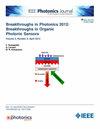Performance Analysis of RIS-Aided Hybrid RF-FSO Communications With Index Modulation
IF 2.4
4区 工程技术
Q3 ENGINEERING, ELECTRICAL & ELECTRONIC
引用次数: 0
Abstract
This work investigates the performance of a hybrid communication system that integrates radio frequency (RF) and free-space optical (FSO) systems for backhaul networks. In this framework, both the RF and FSO links are enhanced by reconfigurable intelligent surfaces (RISs) and employ index modulation (IM) for link switching. The fading in the RF link is modeled using the Nakagami-m distribution, while the FSO link is affected by attenuation, turbulence, and pointing errors, with turbulence characterized by the Gamma-Gamma distribution. Link switching is performed through index modulation, where the selection of the transmission link conveys information bits. We derive exact closed-form expressions for the probability density function (PDF), cumulative distribution function (CDF), and moment-generating function (MGF) of the signal-to-noise ratio (SNR) for RIS-assisted FSO links. Utilizing these SNR statistics, we compute the outage probability (OP), average bit error rate (ABER), and ergodic capacity (EC) of the proposed hybrid RF/FSO system. In the numerical results, the performance of the proposed hybrid RF/FSO system is compared against other systems, including hybrid systems using index modulation without RISs, RIS-assisted FSO systems, and hybrid systems employing hard switching techniques. Finally, Monte Carlo simulations are carried out to validate the accuracy of the theoretical results.索引调制下ris辅助RF-FSO混合通信性能分析
这项工作研究了一种混合通信系统的性能,该系统集成了用于回程网络的射频(RF)和自由空间光(FSO)系统。在该框架中,RF和FSO链路都通过可重构智能面(RISs)增强,并采用索引调制(IM)进行链路切换。RF链路中的衰落使用Nakagami-m分布建模,而FSO链路受衰减、湍流和指向误差的影响,其中湍流由Gamma-Gamma分布表征。链路交换是通过索引调制进行的,其中传输链路的选择传递信息位。我们推导了ris辅助FSO链路信噪比(SNR)的概率密度函数(PDF)、累积分布函数(CDF)和矩生成函数(MGF)的精确封闭表达式。利用这些信噪比统计数据,我们计算了所提出的混合RF/FSO系统的中断概率(OP)、平均误码率(ABER)和遍历容量(EC)。在数值结果中,将所提出的混合RF/FSO系统的性能与其他系统进行了比较,包括使用无RISs索引调制的混合系统,ris辅助的FSO系统以及采用硬交换技术的混合系统。最后,通过蒙特卡罗仿真验证了理论结果的准确性。
本文章由计算机程序翻译,如有差异,请以英文原文为准。
求助全文
约1分钟内获得全文
求助全文
来源期刊

IEEE Photonics Journal
ENGINEERING, ELECTRICAL & ELECTRONIC-OPTICS
CiteScore
4.50
自引率
8.30%
发文量
489
审稿时长
1.4 months
期刊介绍:
Breakthroughs in the generation of light and in its control and utilization have given rise to the field of Photonics, a rapidly expanding area of science and technology with major technological and economic impact. Photonics integrates quantum electronics and optics to accelerate progress in the generation of novel photon sources and in their utilization in emerging applications at the micro and nano scales spanning from the far-infrared/THz to the x-ray region of the electromagnetic spectrum. IEEE Photonics Journal is an online-only journal dedicated to the rapid disclosure of top-quality peer-reviewed research at the forefront of all areas of photonics. Contributions addressing issues ranging from fundamental understanding to emerging technologies and applications are within the scope of the Journal. The Journal includes topics in: Photon sources from far infrared to X-rays, Photonics materials and engineered photonic structures, Integrated optics and optoelectronic, Ultrafast, attosecond, high field and short wavelength photonics, Biophotonics, including DNA photonics, Nanophotonics, Magnetophotonics, Fundamentals of light propagation and interaction; nonlinear effects, Optical data storage, Fiber optics and optical communications devices, systems, and technologies, Micro Opto Electro Mechanical Systems (MOEMS), Microwave photonics, Optical Sensors.
 求助内容:
求助内容: 应助结果提醒方式:
应助结果提醒方式:


